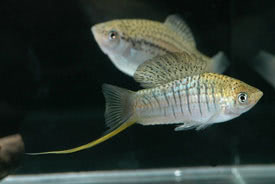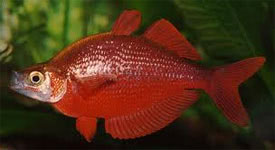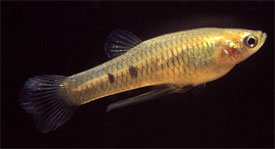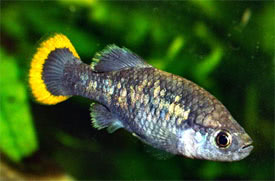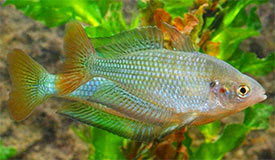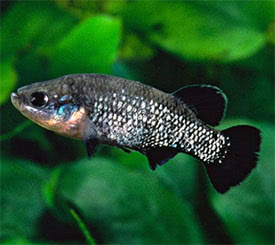Chaetostoma formosae - Striped Bulldog Pleco
 Magyarul / Hungarian
Magyarul / Hungarian

 Magyarul / Hungarian
Magyarul / Hungarian
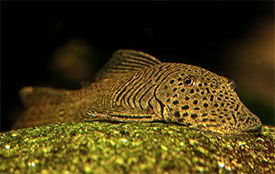
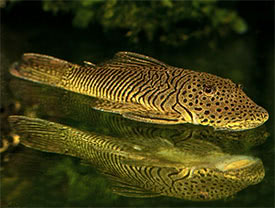
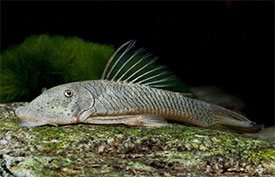
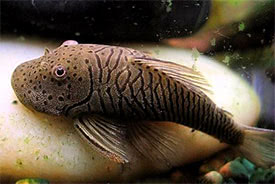
- Scientific name: Chaetostoma formosae
- Synonyms: L-444 catfish, L-187b catfish, Blonde Bulldog Pleco, Striped Rubber Pleco, Striped Rubbernose Pleco
- Common name: Striped Bulldog Pleco
- Group: Catfish
- Distribution: South America; East Colombia; in the upper Rio Meta and Rio Guaviare basins.
- Size: 9-10 cm
- Biotope: Found only in clearwater, fast-flowing rivers with a substrate of scattered rocks and boulders. Riparian vegetation and submerged leaf litter are common in these waters, but aquatic plants aren't usually present.
- Social behavior: A slightly shy catfish that usually active during the night, and should be kept in a species tank, or possibly with a school of peaceful characins. They can be territiorial with congeners and similarly-shaped fishes, so many hiding places are essential for them.
- Diet: Omnivorous; In the wild they feed on algae, or biofilm that found on underwater surfaces, and small insect larvae. In the aquarium they should be fed with small live and frozen foods such as bloodworm and artemia, beside fresh alage.
- Breeding: Very rare in aquarium.
- Tank: Minimum 90 litres
- Population: 4-5 fish for 140 litres
- Decoration: Most importantly their water must be clean and well-oxygenated, so an oversized filter with an additional powerhead are essential. The turnover rate of the pump can be 10-15 times of the tank volume per hour. The substrate can be sand or small gravel with a lot of water-worn rocks and pebbles. The lighting can be bright that encourage algae growth.
- Temperature: 20-24 °C
- pH: 6.5-7.8
- Hardness: 8.0-25.0 dGH
- Lifespan: 8-10 years
Description: Chaetostoma formosae has a pale olive-green body color with dark spots restricted to the head. All fins are clear, but each body armour plate is bordered with black color, creating an attractive series of diagonal lines on the body. This is the most commonly available member of the genus in the aquarium hobby, but still it is often misidentified as Chaetostoma thompsoni, a rare species that has likely never been exported.
In their natural habitat the water is clear and well-oxygenated and there is rich biofilm development on the submerged surfaces. The water turbidity, volume, and chemistry can change rapidly and often due to heavy rainfall. Its sleek, streamlined body is an adaptation for living in this turbulent habitat. If unable to grow sufficient algae in their main tank it may be necessary to maintain a separate small tank in which to grow algae: set it up near to the window so it can get direct sunlight, and place some flat rocks into it. After a few days switch them with those in the main tank.
Mature males are longer, have broader heads, and exhibit more pronounced odontote development on the pectoral-fin spines than females. Males also have disproportionately large pelvic fins, which perhaps play a large role in the fertilization of the eggs. By inverting these over the clutch of eggs, they prevent their sperm being carried away too fast in the current.
They can be bred in aquarium, but only a few reports are available, tending to occur in well-established set-ups where the eggs are deposited on the roof of a cave and defended by the male. The yellowish eggs are quite large with 4 mm in diameter, and their numbers can reach 70-80.
Sources:
http://www.fishbase.se/summary/chaetostoma-formosae.html
http://www.seriouslyfish.com/species/chaetostoma-cf-thomsoni/
https://www.planetcatfish.com/common/species.php?task=&species_id=318
https://www.planetcatfish.com/shanesworld/shanesworld.php?article_id=242
http://www.fishforums.net/threads/blonde-rubber-lipped-plecostomus-chaetostoma-formosae.422830/
http://www.aquatropic.com/news/the-rubbernose-pleco-chaetostoma-formosae
http://www.scielo.br/pdf/paz/v51n26/01.pdf
http://www.fishbase.se/summary/chaetostoma-formosae.html
http://www.seriouslyfish.com/species/chaetostoma-cf-thomsoni/
https://www.planetcatfish.com/common/species.php?task=&species_id=318
https://www.planetcatfish.com/shanesworld/shanesworld.php?article_id=242
http://www.fishforums.net/threads/blonde-rubber-lipped-plecostomus-chaetostoma-formosae.422830/
http://www.aquatropic.com/news/the-rubbernose-pleco-chaetostoma-formosae
http://www.scielo.br/pdf/paz/v51n26/01.pdf
Hasonló vízparamétereket igénylő fajok




